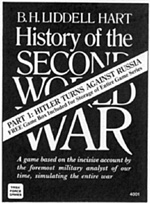
Designed by Nick Schuessler
Task Force Games 1110 N. Fillmore, Amarillo, TX 79107
Released: September, 1984
Catalog No: 4001
Price: $9.95
Complexity: Experienced
Solitaire Suitability: Good
Hitler Turns Against Russia is the first part of multi-game series based on B. H. Liddell Hart's History of the Second World War. The game is of interest for the design, even if the execution leaves something, a few things actually, to be desired.
This initial installment includes a 16" x 20" map of the Eastern Front, a reference card, counters for the Soviet and Axis forces, status sheets, rules, and die. The rules cover ground combat and whole chunks of the complete system are, for the moment, left out. The impression is that all the rules of this part are subject to later additions and changes. The rules even carry an "effective date" to be superseded as new games are issued.
Through five scenarios, Part I re-enacts the "Russian War," from the heady onset of Operation Barbarossa to the shattering retreat of the German Wehrmacht to the Fatherland. The sequence of play for this part is very simple. Each side carries out Ground Operations, and then a variety of activities under the heading of Logistics.
During Ground Operations, each player takes turns moving a single unit up to the limit of its movement allowance. Since a turn is considered to be a month long, a unit receives a 30-day movement allowance, which translates to 30 movement points. It costs a varying amount of points to cross different types of terrain (which may be developed or undeveloped) as well as initiate combat. The climactic region type also affects movement, and motorized units move more speedily in all cases. Once a unit ceases to move or attack, its turn ends. Players cannot come back and use up any units left over movement points.
Combat occurs when a unit enters a space occupied by an enemy unit. The attacker selects a combat mode (Normal, Breakthrough, or Encircle) and the defender selects one of four defensive options ranging from Counterattack to Withdraw. Each combination (there are 12) can be found on an intriguing combat matrix, and each represents a different combat situation. The matrix tells the attacker which of three Combat Results Tables (CRT) to check and any special rules to apply
The CRTs yield two numbers, one for the attackers percent loss, and one for the defender's loss. Players calculate this percent of the unit's base strength and subtract it from the unit's current strength. Units lose strength factors first, and then the actual components of the unit (infantry, panzers, etc.) are removed.
During Logistics, players determine if their units are in supply and a new base number is calculated for the units. Formations can also be transferred from one unit to another. Lastly, initiative and weather are determined for the coming month.
The key to all of this is the status sheet. Each army (USSR, German, and Axis allies) has a Ground Forces Status Sheet. It records the movement points each unit has used (very important in case the unit wants to counterattack), the base strength of each unit, current strength (and armor factors), and the composition of the unit. As the war wears on, the sheet is changed to reflect the declining strength of the units.
Well, then, how does all this work? The game mechanics are straight forward. As Naval and Air Power become integrated into the system in the later parts, this may change somewhat. But the system, as it stands, is quite playable. The alternating unit movement feels odd to use but makes for exciting give-and-take during a turn. The status sheet also gives a heightened sense of what the Eastern Front campaign must have been like.
Bookkeeping is the games major drawback. A calculator is a must for computing combat losses, and the process grows wearisome. Added to that, the status sheet is constantly being erased, amended, and then erased again. While not an insurmountable obstacle to this realistic simulation, it does detract from the playability and fun of the game.
The overall presentation of the game is somewhat strange. The rules are three-hole punched and designed to fit into some ultimate History of the Second World War binder. As such, there are blank pages for future rules (labeled, in large letters, "Blank Page"). Many pages contain paragraphs listing rules items "to be published." This part of History is, indeed, only part. it will be a while before we see the true shape of the beast. Meanwhile, you have the rules for Part I and a suggestion of things to come.
Ah, yes. The map. To say its disappointing is probably an understatement. It is considerably below state-of-the-art and contains cosmetic blunders that should have been corrected. Sure you can play on it ... it just isn't too pretty to look at. Counters are adequate, if umnspiring.
It is an unusual game, then, but one of definite interest. The system seems to draw on other breaks from the traditional counter-with-numbers (i.e. The Avalon Hill Game Company's Hitler's War) but here the simulation is more detailed. While I may not replay Hitler Turns Against Russia, I will certainly be interested in playing each part as they appear.
More Reviews
-
Game Review: Panzer Command
Game Review: Southern Front (WWIII)
Game Review: Liddell Hart's Second World War
Game Review: Royal Navy
Game Review: Hitler's War
Game Review: Sixtomania
Game Review: Rush Hour
Game Review: Constellation
Game Review: Dr. Who
Game Review: Invasion US, Rogue 417
Game Review: Fringeworthy (sci-fi RPG)
Game Review: Super Squadron (Superhero RPG)
Back to Table of Contents -- Game News #3
To Game News List of Issues
To MagWeb Master Magazine List
© Copyright 2000 by Dana Lombardy.
This article appears in MagWeb (Magazine Web) on the Internet World Wide Web.
Other military history articles and gaming articles are available at http://www.magweb.com